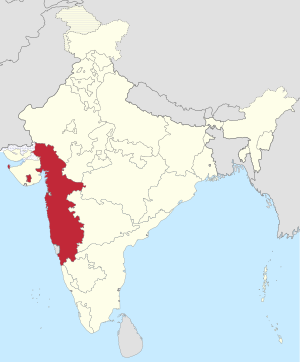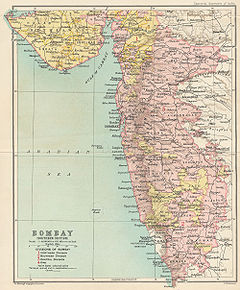Bombay | |||||||||||||||||||||
|---|---|---|---|---|---|---|---|---|---|---|---|---|---|---|---|---|---|---|---|---|---|
Former State 1950–1960 | |||||||||||||||||||||
| State of Bombay | |||||||||||||||||||||
 Location of Bombay in India | |||||||||||||||||||||
| Country | India | ||||||||||||||||||||
| Region | West India | ||||||||||||||||||||
| Formation | 1950 | ||||||||||||||||||||
| Bifurcation | 1960 (into Maharashtra and Gujarat states) | ||||||||||||||||||||
| Consolidation | 1956 (merged Kutch State, Saurashtra State and Vidarbha) | ||||||||||||||||||||
| Capital and largest city | Bombay | ||||||||||||||||||||
| Government | |||||||||||||||||||||
| • Governor | |||||||||||||||||||||
• 1950–1952 | Raja Maharaj Singh (First) | ||||||||||||||||||||
• 1956–1962 | Sri Prakasa (Last) | ||||||||||||||||||||
| • Chief minister | |||||||||||||||||||||
• 1946–1952 | Balasaheb Gangadhar Kher (First) | ||||||||||||||||||||
• 1956–1960 | Yashwantrao Chavan (Last) | ||||||||||||||||||||
| Time zone | UTC+05:30 (IST) | ||||||||||||||||||||
| |||||||||||||||||||||


Bombay State was a large Indian state created in 1950 from the erstwhile Bombay Presidency, with other regions being added to it in the succeeding years. Bombay Presidency (roughly equating to the present-day Indian state of Maharashtra, excluding Marathwada) and Vidarbha) was merged with the princely states of Baroda, Western India and Gujarat (the present-day Indian state of Gujarat) and the Deccan States (which included parts of the present-day Indian states of Maharashtra and Karnataka).
On 1 November 1956, Bombay State was re-organized under the States Reorganisation Act on linguistic lines, absorbing various territories including the Saurashtra and Kutch States, which ceased to exist. On 1 May 1960, Bombay State was dissolved and split on linguistic lines into the two states of Gujarat, with Gujarati speaking population and Maharashtra, with Marathi speaking population.[1]
- ^ Ramachandra Guha, India after Gandhi: The History of the World's Largest Democracy. HarperCollins, 2007
